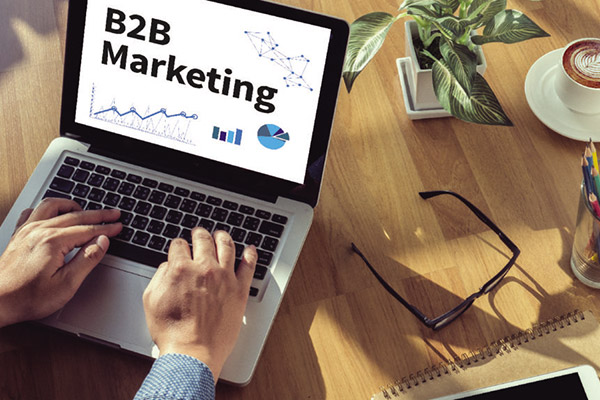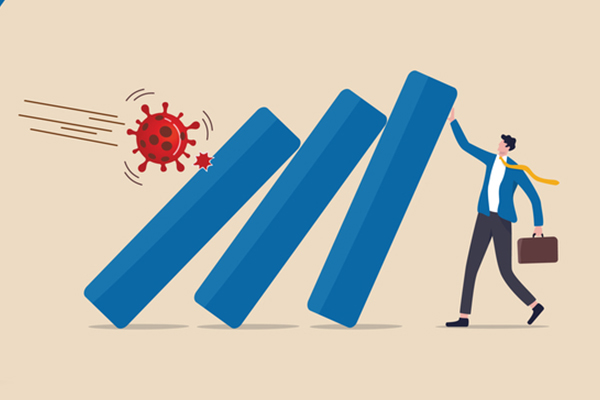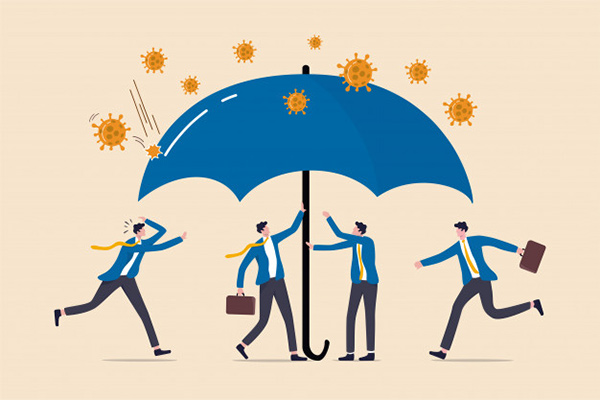Rethinking B2B marketing & sales post-COVID-19
Rajesh Pandit, Management Consultant, Bangalore; Peeyush Gupta, Vice President, Marketing & Sales, Tata Steel, Kolkata, and D. V. R. Seshadri, Clinical Professor of Marketing, ISB, Hyderabad, assert that as B2B marketing & sales have turned topsy-turvy in the COVID-19 world and beyond, the marketing & sales function of the supplier firm in business markets will have to reinvent itself to stay relevant. This article provides a blueprint for this journey of reinvention.

Image credit: Marketmakers
B2B Marketing & Sales has turned topsy-turvy in the COVID-19 world and beyond!
In more ways than one, the COVID-19 crisis is truly an unprecedented and cataclysmic event for B2B companies across the world. The entire dynamics of customer interactions have changed. Earlier, these used to be largely driven by face-to-face interactions. When you are meeting face-to-face, there is an eyeball-to-eyeball contact and the customer can make out from your body language, whether you are trustworthy to do business with him/her.
However, in the new post-COVID-19 era, face-to-face B2B selling has gone through the window and it may remain so for a long time. Instead, in most cases, customers will prefer to have digital interactions. This rebooting will be a major challenge for companies of hues. In that context, the pertinent question that requires urgent answers is:
“How can Marketing & Sales reinvent itself?”
There are three major challenges that businesses of today must contend with. These challenges precede the COVID-19 crisis. COVID-19 has added a huge layer of complexity on top of these three challenges.
The first of these is the shorter shelf life of any product or service that you bring to the market, irrespective of whether you are catering to B2B or B2C markets. This puts a tremendous pressure to constantly innovate your market offering. Such innovation must encompass multiple dimensions: product, service, solutions, experiences, etc.
The second challenge is that in general, the customer, whether in B2B or B2C markets, has a plethora of options. This is particularly relevant for a market like India, where intense entrepreneurial energy has been unleashed over the last several years. This spirit of entrepreneurship will get a major boost consequent to India (and many other nations) deciding to jettison China as the primary supplier of manufactured goods. China has become a country that no nation wants to do business with, due to its obsessive expansionist policies and the fact that it had willy-nilly unleashed on a gigantic scale, the COVID-19 misery on the world.

Image credit: Freepik
While in the past, it was believed that China possesses massive competitive advantage vis-à-vis other countries for producing manufactured goods, with increasing isolation of China due to its current standoff with the world, this vacuum will doubtless be filled by other countries, including Taiwan, Vietnam, India, Mexico, etc. The resurgence of nationalistic fervour being demonstrated by most countries across the world against China is likely to stay for a long time. Governments across the world are consequently restricting Chinese imports. In the past, most countries did not think of India as a source of manufactured products. We think that this perception will now change, making India a favoured country for a variety of products.
The third major challenge is that size does not matter anymore. Just born start-ups will increasingly challenge established incumbents. Today if you have a good idea, it does not matter if the competition is GE or ABB or some other well-established company. There is a lot of money in the form of venture capital, angel investment, government support, etc that is available for funding good ideas.
For instance, if you are a manufacturer of air conditioning systems for cooling offices, it does not take very long for someone to copy your product and even improve on it on dimensions such as energy efficiency, reliability, etc. The same is true for any product – office furniture, machinery, electronics, etc. Whenever you come up with an innovation, competitors are likely to quickly copy your offering, since it is not very difficult for them to reverse engineer your product and improve on it. Therefore, the pace of innovation for all companies will have to become frenetic in the coming years.
As an illustration of this breakneck speed of innovation, recently, there was news that HP had come up with a quantum computer that was superior to IBM’s product. No one could have imagined that IBM would become a laggard in this space. Now these companies will be playing catch up with each other. This is the same reality for every company. What has been said about commoditisation of products is also true for services.
Typically, all suppliers of a product in a market might say, “We have the same offering.” The customer is clearly confused when all suppliers of a product tout the same line! It is a challenge for the supplier firm’s Marketing & Sales function to help the customer firm cut through this clutter.
Ideally, marketing is supposed to inform sales on how to come out of this problem of “commoditisation.”
Mind your personal Facebook profile!
Social media has come into B2B marketing in a big way; you cannot avoid it! Earlier, the perception was that it is more applicable in the B2C markets. Today, it is very much a part of B2B markets as well. A company that ignores this powerful media will be doing so at its own peril. Research points out that 80% of the decision making in B2B markets is done before the customer sees or even hears from the supplier.
In the past, the supplier-customer interactions used to be done through face-to-face meetings. Post-COVID-19, the customer makes up his mind (or nearly so) even before the supplier knocks on the customer’s door to make the sale. This is due to the pervasive power of Internet, Search Engines, Social Media, etc.
The customer is going to check you out thoroughly. He will check whether your website is enticing, informative and honest. But the customer will also check you out on Facebook and LinkedIn. He knows that although you are a marketing/salesperson of XYZ supplier firm, you have your own strong beliefs, likes and dislikes. It could even be a personal remark you made on your social media pages that does not go well with the customer’s ideologies. The sale ends there!
Everything is compressed into a few clicks – your tastes, likes, dislikes, etc., are all known to the customer before you even step into his office to initiate the selling process!
In the past, personal life was just that, personal life! Now all of it is in the public domain. Your Social profile as a salesperson will therefore influence purchasing behaviour like never before. Customers may even check out your friends and their profiles.
At the same time, one of the biggest challenges for the marketer is to educate the customer through content marketing. There is little scope for you as a salesperson to get away with “vapourware”, claiming that your offering is “the best.”
How do you engage your customer digitally in this new age?
In the new reality of B2B Marketing & Sales, the customer is likely to ask the supplier, “Show me the case studies of your successes with other customers!” An example of such case studies could be:
“We sold our suspension systems to Indian Railways and they withstood the bullet train trials. The Indian Railways saved some Rs. 6,000 million annually (US$ 1 = INR 76) by not having put their coaches through emergency breakdown maintenance.”
The second aspect is sharing best practices: can you educate your customer on best practices they could use and demonstrate their utility to him/her? You must realise that the customer is also facing intense competition and needs every input you can provide as a supplier to help him to constantly improve.
The third element is to provide the customer with simple “How to guides.” For the customer, talented human resources to operate your complex offerings are going to be scarce. Hence, digital “how to guides” on your product and service offerings become critical.

Image credit: https://bit.ly/30sm2kd
Fourthly, can we honestly educate the customer that the offering that we are providing is the way the world is going? If I am not able to communicate that, it will be difficult to get the customer’s attention. It is not possible in the new reality of today for a salesperson to con the customer and hope to walk away with a sale. The customer learns from ten other of your industry peers on what is trending in terms of technology. It is here that integrity becomes vital. This means that it is hard to get away with thinking something, saying something else and doing something totally different. Thanks to the power of the Internet, exaggerated claims made by the salesperson will be torn into shreds within seconds by the customer.
Product features and competitive comparisons were the primary sources of information for the customer in the past. They were also the primary sources of competitive advantage for the supplier. While these are still important, there are other factors as presented above, that are vital. This is the reason why the marketing & sales functions of the supplier organisation should inform the customer firm in a comprehensive manner through “content marketing.”
In our view, these shifts are permanent and are not going revert to what prevailed in the pre-Covid-19 era. Once the world is used to this new normal, it is very unlikely that the old forms of supplier – customer interactions will resurface once the current crisis abates. This makes the reinvention of marketing & sales even more urgent.
The sales profession is entering a sustained period of flux
Are customers avoiding salespersons? Are they resorting to online purchasing? Non-strategic buying (such as: office furniture, stationery, air conditioning, travel services, etc.) is moving to online marketplaces. In India, this shift has been slow, but COVID-19 has given this change process huge acceleration. There are enough successes in the developed world where this transformation has essentially been complete.
India too is fast catching up. There are over 100 online platforms in India, catering to B2B markets.
This does not mean fact-to-face interactions are going to become extinct. In many buying scenarios, customers would still like to have face-to-face meetings for the first-time purchase of non-trivial products or services. In the post-COVID-19 world, this may happen through calls on platforms such as Skype, Zoom, MS teams, etc., since face-to-face meetings are no longer feasible. However, these technologies are rapidly advancing, making such meetings close approximations to the old-world face-to-face meetings. For the second purchase of the same offering, the propensity to have such meetings will be considerably less. For repeat purchases, procurement will move totally online.
Marketing is the new king in the supplier firm!
In the past, if you consider relative importance of marketing and sales in a supplier firm in B2B markets, the split was 25:75, i.e., around 25% of the cerebration and activity that preceded sales thinking was essentially in the realm of marketing, and 75% in the realm of sales. With all the tectonic shifts that have taken place as described above, today this proportion has flipped. In terms of importance, marketing thinking in the new world is likely to be 75% and sales thinking 25%.
“Trust” is now more important than ever before!
The biggest casualty in the post-COVID-19 world is “Trust.” However, with no face-to-face contact, trust becomes difficult to establish.
Trust is the fundamental bedrock for B2B relationships, which tend to be established and sustained for the long-term. It takes years to build this Trust. In a post-COVID-19 world, in the absence of face-to-face meetings between the supplier firm and customer firm, you must think creatively on how Trust can be fostered and strengthened.

Image credit: Freepik
This is where salespeople must think out of the box. Today, in the absence of face-to-face contacts, you do not have a lot of opportunities to build Trust. The digital world is far too crowded, with attention deficit being a severe problem. It is therefore imperative for the salesperson to articulate value in a way that captures the attention of the customer. In turn, superior value consistently delivered, keeping the interest of the customer firm uppermost in the mind of the salesperson, is likely to foster Trust.
“Value” (i.e., the economic value that the customer can derive from the supplier’s offering) and “Trust” are essentially two sides of the same coin.
The customer firm’s buying journey typically comprises the following stages:
Awareness – Exploring solutions – Comparing various vendors – Purchase
In the past, marketing was focussed on awareness creation, while the next three stages used to be handled by sales. In the new digital world, only the last step falls within the scope of sales, while the first three are squarely in the realm of marketing. Therefore, the importance of marketing has skyrocketed.
Given the above scenario caused by rapid digital transformation, a lot of salespersons may increasingly find themselves becoming redundant. Onboarding of new employees in the sales function will slow down.
Employees across different functions and levels in the organisation must find ways to demonstrate agility and flexibility, while manifesting a “marketing mindset.”
In fact, the future could see more contractual employment, with extensions being given based on performance. Further, we would advise salespeople to have extended stints in marketing, to enhance their skill sets.
The imperative of accelerating the digital transformation journey
The above discussion points to the urgency for companies to accelerate their digital transformation journey. This calls for a quicker adoption of systems, recoding of software, enabling new hardware and capability build-up of peopleware. Of these, the capability build-up of people has always a huge challenge with Gen X managers (the ones belonging to the older generation). However, the COVID-19 lockdown seems to have achieved the impossible! Many of these managers have quickly adopted to various digital technologies. The key issue is now to make this transformation sustainable so that even after the crisis has passed, the new normal stays on and digital become the way of life.
Conclusion: Winners of the future must think and act fast
To summarise, we feel that B2B companies with the following key characteristics stand a chance to excel in the post-Covid-19 world:
– High flexibility and agility
– High-speed decision-making. There is no problem if you make two right moves and one wrong move! The key is to move ahead at high speed!
– Versatility in people – one cannot stick to a narrow role, especially in the light of the common occurrence of “downsizing” that is common across organisations. While organisations would continue to need specialists, these same people must be decently competent in other areas.
– Empowerment of people is key.
– A culture of empathy within the organisation and with customers (salespeople).
– Creativity to craft win-win solutions for both supplier and customer firms
– Simple and clutter-free ways of doing business
– One significant change that Marketing and Sales must undergo. For Marketing, how to contact new customers in micro segments and for Sales, how to serve the existing & new customers in a digitally transformed market.
In conclusion, every company operating in business markets must find ways for “accelerating adoption of digital.” This is a clear imperative to serve B2B markets in the post-COVID-19 world. Those companies that succeed in this transformation will prosper; the rest will languish or become extinct.

Rajesh Pandit has 25 years of experience across industry and academia and is a management consultant based out of Bangalore. He is a Visiting faculty at IIM Ahmedabad, Udaipur and Shillong for over 8 years and strategic adviser to multiple organizations in Leadership development, Business Growth, Sales and Marketing areas.
Rajesh is a principal faculty in areas of Customer orientation, rejuvenation of sales pitch, Sales excellence and Intrapreneurship for customers across industries including reputed organizations like Aditya Birla, Robert Bosch, TE Connectivity, KPIT Technologies and Wipro. He has worked closely with textiles division of Aditya Birla in initiatives to rejuvenate customer value proposition to overcome commoditization, improving profitability by 25%. He can be contacted at Rajesh.Pandit@gmail.com

Peeyush Gupta is working as Vice President – Steel (Marketing & Sales) and has a revenue responsibility for Indian Operations of Tata Steel.
An MBA in Marketing & Finance from McGill University, Canada, he is with Tata Steel for over 25 years and has worked in various functional areas at Indian & SE Asian operations that include Strategy, Finance, Performance Improvement Programs & International Trade. Prior to taking over this responsibility, he was President & CEO of Tata Steel (Thailand) plc. In addition, he is a Chevening Scholar from Leeds Business School and has done Senior Management Development program at CEDEP, France.

DVR Seshadri is the Director for ISB-CBM and Clinical Professor in the Marketing Area at the Indian School of Business. His areas of interest are business-to-business marketing, corporate entrepreneurship, and strategy. He had over 15 years of industrial experience before joining academics since 2000. Before joining ISB in 2016, he taught at IIM, Bangalore, and at IIM, Ahmedabad, as visiting faculty. He works closely with several companies, providing them training and consulting services in his areas of expertise. After joining academics twenty years ago, he has developed over 100 case studies, authored several research papers and co-authored five books.













That’s quite informative! Thank you for sharing it with us! I believe that as a business, you must invest in chatbot technology so that you don’t have to see your customers departing to your competition. Check out this link to see how you can have an edge over others – http://s.engati.com/2r4
I am into B2B sales and worked with different government verticals, and also an alumna of IIM Udaipur where I got to learn from Rajesh Sir & DVR Sir.
The article is detailed and relevant to today’s problems of being a B2B Salesperson. It is quite impressive how you have captured minuscule details of the salesperson day to day journey.
Excited to mention that I am also a firm believer in “Empowerment is the Key”.
Apart from being such an inspiring article, it does miss the enigma of Selling to Indian government customers. As in real-world, only a few understand & able to do video calling, and rest are working in silos and not interested to be a part of digital transformation until forced to be.
Love to hear and understand your perspective here.